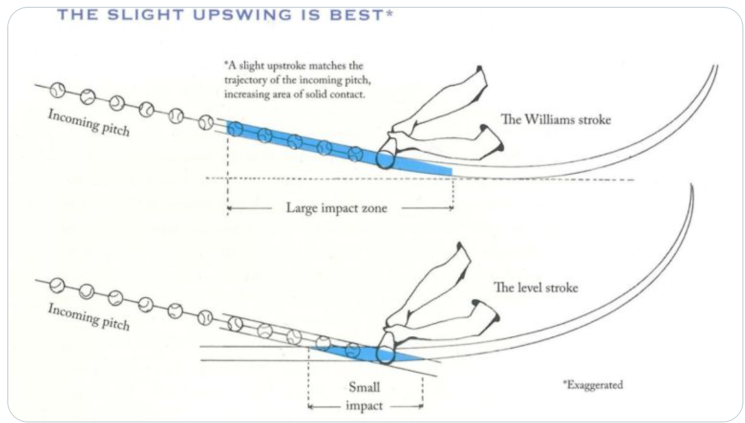
Baseball's Launch Angle Revolution
By Ken Cherryhomes
Preface
Have you ever wondered where the obsession with launch angles comes from? It’s one thing to say, “too many hitters today are swinging from their asses”. That’s an easy enough observation. The question that remains is, why?
A few years back, I wrote an article that was published by Inside Pitch magazine (May/June 2019) titled, In Pursuit of the Optimal Swing. It was an op-ed of sorts, to physicist Alan Nathan’s article, Optimizing the Swing, published by Hardball Times (Nov 2015). My article’s purpose was not to disprove professor Nathan’s conclusions of optimal attack angle for maximum flight distance but to offer perspectives not discussed in his article.
Optimizing the Swing was a chronicle of the theoretical physics involving bat swing attack angles (AA) and resultant batted ball launch angles (LA). To a theoretical physicist, the “how” component is of no concern, only the if/then conclusion. This is what has led to a bat swing paradigm focused on optimal batted ball launch angles, forsaking swing consistency and adaptability.
After having read Mr. Nathan’s article, I reached out to him before writing my op-ed. We exchanged emails and had phone conversations that revealed he understood very little about bat swings and varying contact points outside of the controlled, fixed parameters in a vacuum.
I explained to him that he was likely responsible for the low batted ball, high strikeout rates we are seeing today. I attempted to explain to him that downward swings have an arc, arriving at different instantaneous attack angles based on the point of contact within that arc. I further explained “down swings” are not intended to make contact while on the downward arc of a swung bat and that making contact with a negative attack angle was generally the product of poor timing. I stressed the importance of understanding how a bat arrives, the path the batter initiates to arrive at a desired attack angle and the negative implications of not articulating this. His response was:
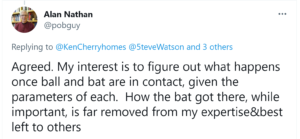
His response was not surprising but his indifference towards the implications of his study, without consideration for application, frustrated me. So, I took it upon myself to educate the public, though I feel my point was missed, which is why I am writing this article today.
What exactly is optimal
When I apply the word optimal, I consider more than just the end result. I consider ease of execution, consistency potential for a desired outcome and margin of error. I base the suggestion that something is optimal considering all possible parameters, not just those within the fixed conditions of a vacuum. Within a vacuum, assumptions can be applied for comparison purposes. Consistency, ease of execution or swing time considerations are not represented. These conclusions, absent of actual swing execution, result in nothing more than an if/then discussion, not a blueprint for swing execution, as it did.
The Ted Williams fallacy
When discussing upward swing paths, it hard not to bring up Ted Williams, arguably the greatest hitter of all time and the last man to bat .400
The question is, did Ted Williams have an upward swing? In a way he did but probably not how you think of an upswing and nothing like the swings you’re seeing in today’s game that are launch angle conscious.
While Ted memorably espoused a slight up swing is best in his seminal book and video that followed, The Science of hitting, a decade earlier, in 1961, the year after he retired, he recommended a level swing was best, down was not bad and swinging up was not good.
Here in 1974, 13-years after recommending a level swing is best, he describes the best swing is a slightly up swing.
It is important to note, Ted Williams was primarily a pull hitter. When pulling the ball, the bat’s barrel is meeting the ball out in front, where the barrel passes the hitter’s hands, turning towards their pull field and more importantly, if the swing path is down or level, it begins to ascend at this point in the swing’s arc. I believe Ted understood this in 1961, which is why he recommended a level or downward swing path.
Here is a random sampling of Ted Williams’ in-game swing. You will not notice a defined upward swing path in any of these swings.
In the clip below of Ted Williams, from his video, The science of Hitting, he demonstrates his swing, which he describes as a “slightly up swing”. You can observe his swing is actually extremely flat, level, throughout most of the swing’s arc and only at contact, where the bat begins its natural ascent, is it “slightly up”.

This famous picture from the book, The Science of Hitting, is used to support the upward swing narrative by a great many coaches today. What these coaches, who apparently don’t have the experience or understanding to interpret, miss, is that the swings depicted are identical but for the colored line illustrating the contact portion of these swings.
In order for a bat swing to maintain a downward path, as illustrated, the hitter would need to lean forward, off axis, for the bat not to ascend. Or, some serious hand tension would have to be applied to keep the barrel working down in an otherwise well-timed swing. Either way, that would not be good and few, if any, recommend making contact that way. “Swinging down on the ball” should not be confused with a downward swing with no arc.
Hank Aaron swinging down while making contact as the bat ascends.
I’d also like to mention the barrel doesn’t travel in a straight line forward, increasing the impact area of the swing, as implied in the illustration. The barrel is turning, therefore, taking the sweet spot of the barrel with it. We are not swinging golf clubs, for which this illustration might be more applicable, since the club head works forward linearly but not linearly and rotationally at the same time, like a bat’s barrel.
Below are snapshots from Ted’s video illustrating his slightly up swing. What both Ted and professor Nathan is describing, is the instantaneous attack angle at point of contact, not the swing path itself leading up to contact with the ball.

The above photos depict only at the moment just before contact is Ted’s barrel matching the plane of the pitch.
Interpretation and application of optimal launch angle swing paths
The swing paradigm that has followed, in no way resembles Ted Williams’ swing. What it does resemble is Alan Nathan’s optimal attack angle for maximum flight distance of around 18ﹾ, that is being applied to all pitches! Remember, Ted was a dead pull hitter, something Alan Nathan doesn’t understand or care about, because his exercise was purely theoretical without consideration of execution.
Had Alan noted that an 18ﹾ attack angle occurred naturally when a ball is met during the ascent of the bat’s barrel, while meeting a pitch in front of the batter’s hands and when pulling pitches, perhaps a different approach to hitting flyballs would have followed.
What he did mention in his article, was that high degree attack angles have a larger margin of error than swings that could produce optimal launch angles at lower degrees of attack angle but with slightly less flight distance. Slightly, being the key word not present in his theoretical exercise aimed at determining maximum flight distance of a batted ball, but it was noted and included in my article.
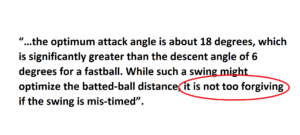
Above, an excerpt from, Optimizing the Swing
My study compared a high degree attack angle (17ﹾ) to an attack angle at contact of 0ﹾ, for a middle pitch meant to be driven to centerfield, same as Professor Nathan’s study. I chose 0ﹾ because that would be the attack angle of a bat’s barrel for a natural, downward, arcing swing prior to the barrel passing the batter’s hands, where the barrel would begin to ascend towards positive attack angles. Note: depending on how far out front the pitch was met, when a downward or level swing begins its ascent, an optimal attack angle of 18ﹾ could be realized without having to take an upward swing.
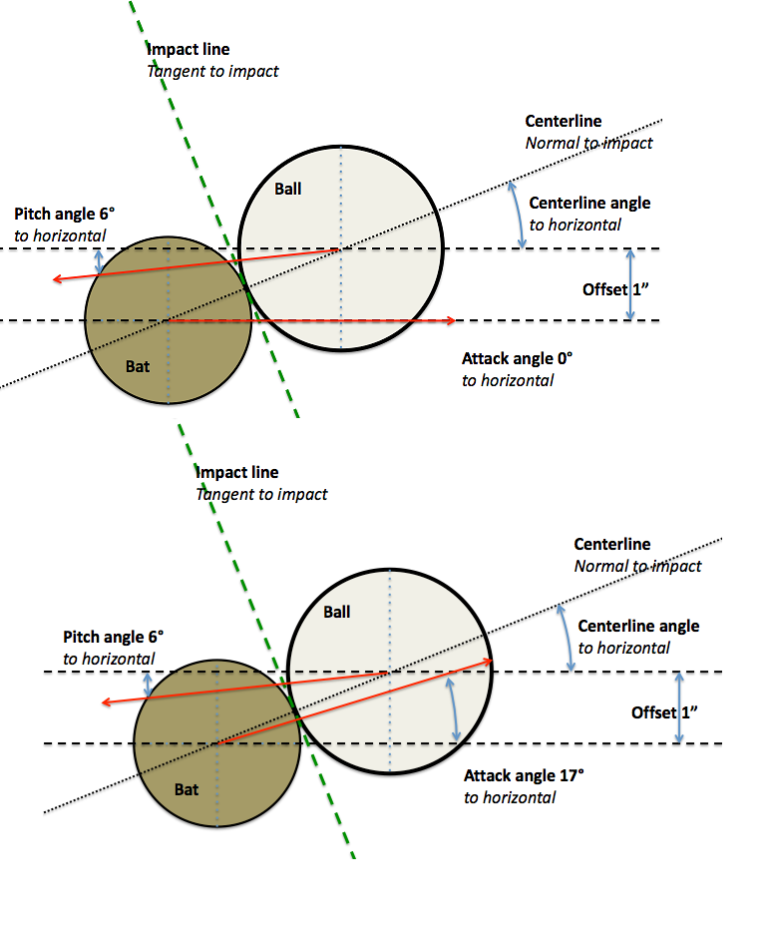
My study didn’t disprove Alan’s conclusions, nor was it meant to. My intention was to illustrate that a swing with a lesser margin of error, with more positive result potential, could produce a similar, albeit, slightly lesser, flight distance. However, when pulling a pitch, a swing that starts out with a consistently lower attack angle over the course of its arc could produce an optimal attack angle of around 18ﹾ at a point of contact with the ball along the swings arc.
The swing type currently used to produce maximum flight distance bears no resemblance to Ted Williams’ swing in any way. High attack angle swing approaches replace Ted’s more level swing for all pitch locations, not just pulled pitches and the result has been higher strikeout rates and fewer balls put in play.
Here is Joey Gallo demonstrating what is commonly referred to as a “launch angle swing”. (I understand all hit balls have a launch angle of some kind. I didn’t name the swing or label the paradigm).
Yes, more home runs are being hit but so are more ground balls and strikeouts, while runs scored over 9-innings is slightly down from the pre-launch angle era. More groundballs, the main objective of avoidance of the launch angle era? Yes. here’s why:
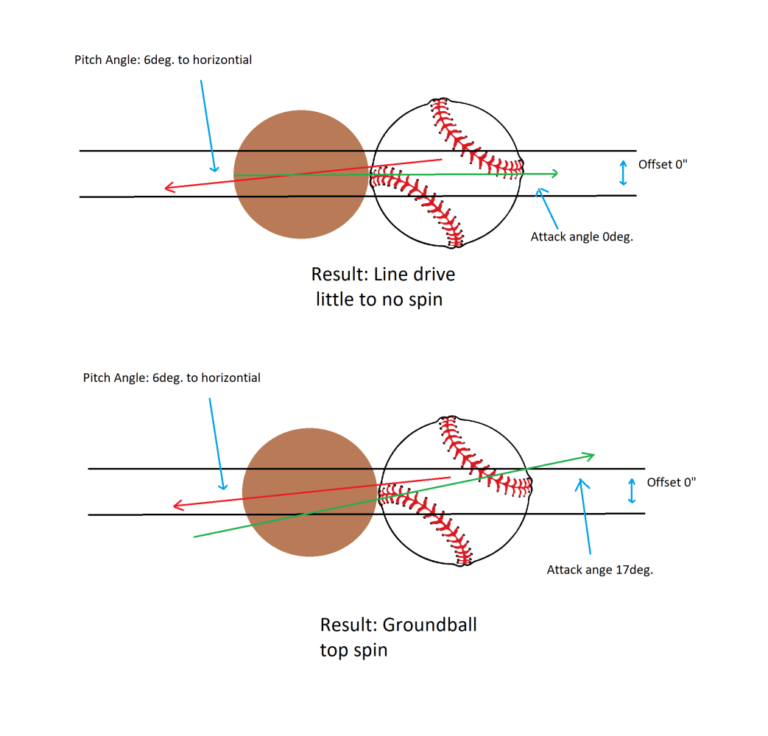
While the point of contact between the bat and ball is identical between the two swings illustrated in the above example, the 0ﹾ attack angle resulted in a line drive hit up the middle, while the 17ﹾ attack angle resulted in a ground ball up the middle, precisely what the upward, high attack angle swing was trying to avoid. It’s highly implausible to swing up and hit a line drive; even less so with any measure of backspin. Why is this important? Flyballs account for the highest percentage of bated ball outcomes with the lowest outcome for a base hit of any kind. Conversely, the least frequent outcome with the highest average for success is the line drive.
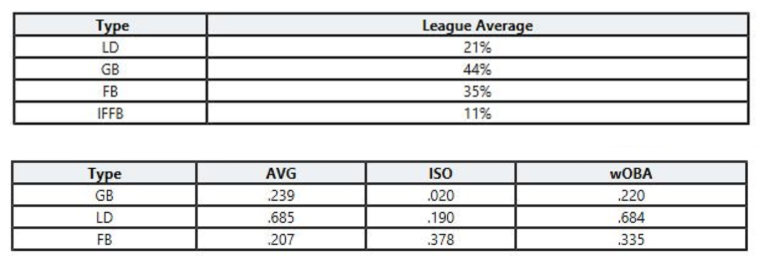
The graphic above was obtained off Fangraphs, which for reasons supporting some narrative, chose to separate infield flyballs from fly balls. If you consider them the same, which I do, the batted ball outcome percentage for flyballs goes from 35% to 46%. Were you were to hit nothing but flyballs, your batting average would be .207 (coincidentally, Joey Gallo’s career batting average is .209 at the time of this writing). Were you to only hit line drives, your batting average would be .685 and many home runs are hit within the launch angle window of what is considered to be a line drive.
Why the analytics departments didn’t ask how line drives are hit, what attack angles are optimal for hitting line drives and why they didn’t ask how can we increase the number of line drives hit, is a mystery.
Because both the ball and bat are round, flyballs, as well as driven flyballs, can be and are hit with lower, more favorable towards desirable outcomes, attack angles. Almost every batted ball has some measure of tangential, obtuse collision between the two. Because of the incoming pitch’s angle and the collision occurring slightly above or slightly below the centerline between the bat and ball, the struck ball with exit some degree of spin, top or back, and a positive or negative launch angle of some kind. Even if met with a 0ﹾ attack angle, dead center between the bat and ball, the ball will line back towards centerfield with some back spin, due to the difference between the bat arriving at 0ﹾ with the pitch coming in at around 6ﹾ. As described earlier, the same is not true were the batted ball met with the same parameters but at a 17ﹾ or 18ﹾ attack angles, because they would result in a topspin grounder.
Analytics, player development and the manipulation of data
It has been made abundantly clear that analytics are driving both the management of a baseball game for most clubs and the same is true for the development of its players. More and more, I have found soft baseball skilled individuals with degrees in finance or data analytics are now replacing seasoned baseball trainers. These individuals take analytics data and translate them to on field coaching personnel who then attempt to convey these objectives to the players as mechanical blueprints.
Since these analytics department folks are assumed to be the smartest people in the room, they likely receive little pushback from upper management and even if their analytics don’t play out, new data, granularized data, explains their projections are correct. After all, who’s checking their math.
The biggest problem is, because they are soft skilled in baseball knowledge, they are limited to the questions their experience allows them to ask, in respect to application of their objectives in physical form. More than a few new metrics and projection based analytics are flat out wrong because too many parameters are not included due to this inability to ask the right questions.

Let me tell you something, Steve, it isn’t hard to understand at all.
Please send questions and comments to:
